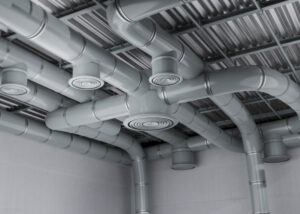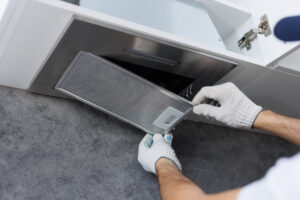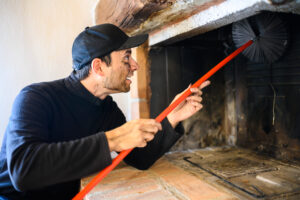As a homeowner, understanding the crucial components of your household appliances is essential for maintaining a safe and efficient home. When it comes to your clothes dryer, two elements play vital roles in its operation: the dryer vent and the lint trap.
While both are integral to the drying process, they serve distinct purposes and require different levels of attention. In this article, we’ll explore the key differences between dryer vents and lint traps, helping you become a more informed and safety-conscious homeowner.
What is a Dryer Vent?
A dryer vent is a duct system that channels hot, moist air and lint particles from your dryer to the outside of your home. This essential component ensures that the warm, humid air generated during the drying cycle is safely expelled, preventing moisture buildup inside your home and reducing the risk of mold growth.
And that’s why it’s important to keep your dryer vent in good condition. A clean and properly functioning dryer vent not only helps prevent dangerous dryer fires by removing lint and hot air, but it also makes your dryer more energy efficient, which can lower your energy bills.
Plus, when your dryer doesn’t have to work as hard due to a clogged vent, it lasts longer, saving you from the cost of a new machine or repairs. Regular maintenance really goes a long way in keeping both your home and your appliances safe and running smoothly!
Understanding the Lint Trap
The lint trap, also known as a lint screen or lint filter, is a mesh screen typically located inside the dryer door or on top of the dryer. Its primary function is to capture lint and small debris from your clothes during the drying process.
Though it may be small, the lint trap in your dryer plays a big role in keeping things running smoothly and safely. Acting as the first line of defense, it catches a lot of lint before it can make its way into the dryer vent. This not only helps maintain proper airflow inside the dryer, making each drying cycle more efficient, but it also plays a key role in fire prevention by reducing the risk of flammable lint building up in the vent. Keeping your lint trap clean is a simple yet essential step in protecting both your dryer and your home!
Dryer Vent vs Lint Trap: Key Differences
Now that we’ve introduced both components, let’s delve into the key differences between dryer vents and lint traps:
1. Location and Accessibility
The dryer vent system usually runs from the back of your dryer to the exterior wall of your home, which means it’s not the easiest to reach without some effort. On the other hand, the lint trap is super accessible—it’s typically located either right inside the dryer door or on top of the dryer, making it easy to clean out regularly.
2. Cleaning Frequency
When it comes to keeping things clean, the dryer vent and lint trap have different needs. Experts suggest cleaning your dryer vent at least once a year, though if your home has a high laundry load or a long vent system, you might need to do it more often. The lint trap, on the other hand, requires more frequent attention—it’s best to clean it out after every drying cycle.
3. Cleaning Process
Cleaning your dryer vent and lint trap involves different levels of effort. The dryer vent often requires special tools and can be a bit more complicated, which is why many homeowners choose to hire professionals for a thorough cleaning. On the other hand, cleaning the lint trap is super easy—it just takes a few seconds to remove the lint by hand or with a brush. Every so often, you can give the screen a wash with soap and water to keep it in top shape. It’s a small task that makes a big difference!
4. Impact on Dryer Efficiency
When it comes to your dryer’s efficiency, both the dryer vent and lint trap play important roles. A clogged dryer vent can have a big impact, causing longer drying times and using more energy, which is both frustrating and costly. While a full lint trap can also affect how efficiently your dryer works, its impact is usually not as severe as a blocked vent. That said, regularly cleaning the lint trap is still essential to keep your dryer running smoothly and performing at its best!
5. Safety Concerns
Safety is a major concern when it comes to both the dryer vent and the lint trap. A clogged dryer vent is especially dangerous because the buildup of highly flammable lint and restricted airflow can lead to overheating, posing a serious fire hazard. The lint trap, while also a fire risk if left full, is much easier to maintain since it’s so accessible.
Signs You Need to Clean Your Dryer Vent or Lint Trap
Being aware of the signs indicating that your dryer vent or lint trap needs attention is crucial for maintaining a safe and efficient laundry routine. If you notice that your clothes are taking longer to dry, this could be a clue that either your dryer vent or lint trap is clogged. Another sign to watch for is excessive heat—if your dryer or laundry room feels unusually hot during use, restricted airflow may be the cause. A burning smell is a serious red flag and needs immediate attention, as it could indicate a fire risk.
Lastly, if you see lint building up around the dryer door or external vent, it’s a clear sign that it’s time for a good cleaning. Staying on top of these issues can help prevent bigger problems down the road!
Maintaining Your Dryer Vent and Lint Trap
Maintaining your dryer vent and lint trap is key to keeping your dryer running safely and efficiently. A simple habit to adopt is cleaning the lint trap after every drying cycle—this quick task helps prevent buildup and keeps your dryer working smoothly. It’s also important to schedule a professional dryer vent cleaning at least once a year, or more often if needed, to ensure your vent is clear and functioning properly.
Don’t forget to check the external vent cover regularly to make sure it’s free from obstructions and opens as it should during dryer operation. Lastly, make sure your dryer vent is made from rigid or semi-rigid metal ducts, as these materials are safer than plastic or foil alternatives. These small steps can go a long way in ensuring both safety and efficiency!
Conclusion
Understanding the differences between your dryer vent and lint trap is essential for every homeowner. While both play crucial roles in your dryer’s operation, they require different levels of attention and maintenance. By keeping your lint trap clean and your dryer vent well-maintained, you’ll ensure your dryer runs efficiently, save on energy costs, and most importantly, reduce the risk of dryer-related fires in your home. Remember, a little regular maintenance goes a long way in keeping your home safe and your appliances running smoothly.





